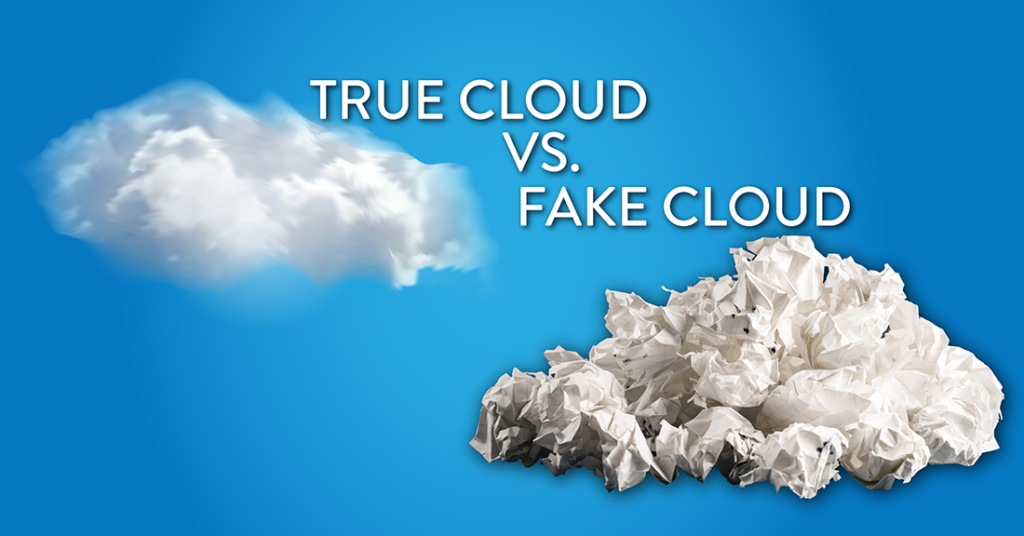Distribution is a complicated business. Ensuring products flow properly, people work effectively, and cash moves smoothly is a necessity, but too often, processes get gummed up and technology becomes more of a hindrance than a help. This is especially true if you are relying on outdated or undersized technology for the job at hand.
Unfortunately, the path to upgrading or replacing business management software for the distribution business is rarely as straightforward as you may hope, with dozens of options available and each vendor going out of their way to say why theirs is “the best.” No one wants to admit weakness in this industry, and unfortunately, some vendors and resellers care more about sales than they care about developing relationships.
There are few trends that point to this more than the rise of ‘fake cloud’ distribution software.
What is Fake Cloud Distribution Software and Why is it Such a Big Deal?
Something that has been trending for the past few years has been the “fake cloud,” a term used to define legacy software modified slightly and hosted in a data center. While technically a cloud software, these products were never designed to be delivered and used in the same way that a real cloud solution would be.
How Fake Cloud Software Came to Be
 Fake cloud distribution software came as a result of shortsightedness. Look back a decade or so to the rise of and realization of the cloud as a viable way to deliver software. While many were still skeptical of the cloud as an enterprise-ready product, built-in-the-cloud vendors were building, securing, and refining their products, playing the long game and readying themselves for a cloud-first world. About seven years ago, the market began to shift and legacy vendors were left trying to catch up.
Fake cloud distribution software came as a result of shortsightedness. Look back a decade or so to the rise of and realization of the cloud as a viable way to deliver software. While many were still skeptical of the cloud as an enterprise-ready product, built-in-the-cloud vendors were building, securing, and refining their products, playing the long game and readying themselves for a cloud-first world. About seven years ago, the market began to shift and legacy vendors were left trying to catch up.
With true cloud vendors ready for the new reality, legacy software providers were not. This meant that in order to compete in this new reality, the old guard would need to discover how to offer “cloud” software. Unfortunately, they were already behind the learning curve and their attempts at creating such a product were flawed—often just their old products offered through an adapter software.
The Problems with the Fake Cloud
Think of your current product—the challenges, lack of integration, poor user experience, and custom coding to get basic reporting. It’s a hassle, right? Now, add to this an additional layer of complexity to access your product, a specialized software needed to access your distribution management platform. This is the essence of the fake cloud, and this is why you can’t afford to fall into a fake cloud trap.
For many businesses, this trap could cost them the visibility, user-friendliness, and integration they need. Among the common warning signs:
- Some require specialized software for access, so the system has limited availability.
- The user interface cannot be personalized by each user. It requires the assistance of a trained programmer.
- The legacy solutions were written in tools and techniques that are not relevant today, and the expertise to modify them is becoming scarcer and more expensive.
- Legacy ERP software may use proprietary tools to integrate third-party applications, making it difficult to communicate with other applications.
- The systems often lack technology tools such as virtualization and load balancing to provide scalability. This restricts system performance.
Learn More: True Cloud vs. Fake Cloud: A Guide for the Distribution Industry
If you’re looking to get the real benefits that exist in the cloud, you need to know what to look out for. At Crestwood, we have helped companies like yours to discover what works for their business, understand the difference between true and fake cloud, and ultimately choose and use the right solution for them. If you are looking to understand the differences and leverage the technology that works for you. We invite you to download the free guide titled True Cloud vs. Fake Cloud: How Companies Can Tell the Difference in Distribution.
In “True Cloud vs. Fake Cloud: How Companies Can Tell the Difference in Distribution,” you’ll find out:
- Three reasons mobile devices alone can’t meet the need for real-time information.
- Four ways the cloud can enhance productivity for distribution companies.
- Five reasons legacy applications don’t play well with the internet.
- Eight ways to identify true cloud software for distributors.
- Where to see true cloud software in action.
Ready to learn more? Explore our work and contact us for a free consultation.
